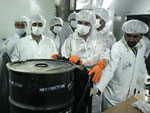 Bloomberg: Iran’s tentative agreement to resume talks over its nuclear program is a hopeful sign. More distressing — and more demanding of a U.S. response — is Iran’s plan to speed up that program. Bloomberg
Bloomberg: Iran’s tentative agreement to resume talks over its nuclear program is a hopeful sign. More distressing — and more demanding of a U.S. response — is Iran’s plan to speed up that program. Bloomberg
By the Editors
 Iran’s tentative agreement to resume talks over its nuclear program is a hopeful sign. More distressing — and more demanding of a U.S. response — is Iran’s plan to speed up that program.
Iran’s tentative agreement to resume talks over its nuclear program is a hopeful sign. More distressing — and more demanding of a U.S. response — is Iran’s plan to speed up that program.
Iran’s Foreign Minister Ali Akbar Salehi agreed on Feb. 3 to talk again with the so-called P5+1 (China, France, Germany, Russia, the U.K. and the U.S.). At the top of the agenda should be Iran’s plans, announced last week, to significantly expand its uranium-enrichment capacity. If implemented, those plans would greatly complicate the U.S. strategy for preventing Iran from acquiring a nuclear weapon, and increase the risk of a military conflict.
The Barack Obama administration wisely wants to put off military action at least until there is evidence of an Iranian effort — and not just capacity — to make a nuclear bomb. But what if capacity morphs into effort and no one notices in time to stop Iran? That will become a realistic scenario if Iran completes its plan to install about 3,000 advanced centrifuges at its underground enrichment facility near the city of Natanz.
Last week’s announcement will almost certainly increase the pressure on the U.S. from Israeli Prime Minister Benjamin Netanyahu to act sooner rather than later on Iran. Netanyahu told the United Nations in September that Iran’s progress had to be stopped before spring or early summer, when it would have the feedstock to produce sufficient fissile material for a nuclear bomb.
Enriched Knowledge
It’s true that in a few months, based on current rates of production at three known enrichment facilities, Iran could increase its acknowledged stockpile of 20 percent enriched uranium from 134.9 kilograms (297.4 pounds) to 250 kg. That’s enough to distill the 25 kg of 90 percent enriched uranium necessary for a sizable nuclear warhead. The installation of some of the advanced centrifuges — which are four to five times as productive as existing ones — could shorten that timeline somewhat. However, Iran will probably need at least nine months to make all 3,000 of the devices operational, and that assumes the country has overcome reported shortages of critical raw materials.
Netanyahu also correctly argued that because the locations of the three enrichment facilities are known, the nuclear program is most vulnerable to military attack during the enrichment phase. If Iranian officials gain sufficient weapons- grade uranium, they could transport the material to a secret workshop and, assuming they have the know-how, assemble a bomb unmolested.
As things stand, Iran has a seemingly plausible — though not credible — explanation for making so much 20 percent enriched uranium. It claims the material is to fuel research reactors, though it has already stockpiled more uranium than it could use for this purpose.
On the other hand, if Iran enriches uranium up to 90 percent, that can have only one purpose: to make a bomb. If this level of enrichment — the “breakout” level — occurs at any of the three identified centers, inspectors would know within a week or so because they monitor all material moving in and out of the centrifuge areas. Should Iran bar the inspectors’ entry or expel them, that would strongly indicate a breakout.
Could military action against Iran in this scenario happen fast enough? According to computations based on current enrichment capacity and speed, once Iran had 250 kg of 20 percent uranium, it would need at least a month to make a warhead’s worth of fissile material, providing enough time for inspectors to notice and for the U.S. to mount a military response. Yet if Iran can get the 3,000 new centrifuges operating, it could cut that time in half.
Game Changers
That would change the game: The U.S. would lose its early warning system that Iran was breaking out.
It would be wise, then, for the U.S. to let Iran know that it would consider the installation of the 3,000 centrifuges one of the factors that could precipitate a military strike. Such a capacity would push Iran’s argument that its enrichment serves civilian purposes from specious to absurd.
Basing a decision for military intervention on anything but the certainty that Iran is trying to build a bomb is not ideal, especially given the intelligence failures that led to the Iraq War. Yet Iran’s unjustifiable nuclear rush forces the issue.
In addition to the talks between Iran and the P5+1, slated for the end of February in Kazakhstan, U.S. Vice President Joe Biden said Feb. 2 that the U.S. is open to direct talks, a more promising prospect. Deep sanctions relief for deep nuclear concessions should be the theme of any new discussions. There is time still for a diplomatic resolution. With each new centrifuge installed at Natanz, however, the window grows smaller.


